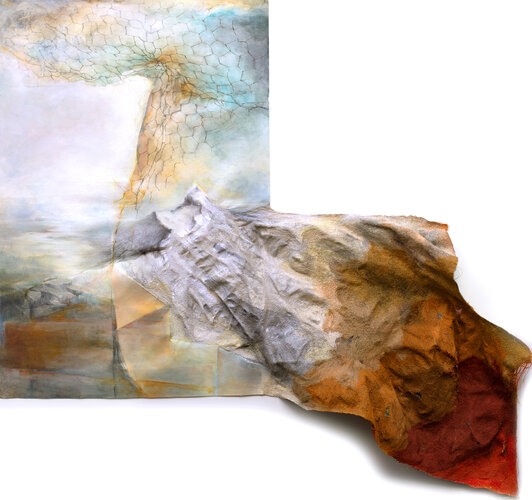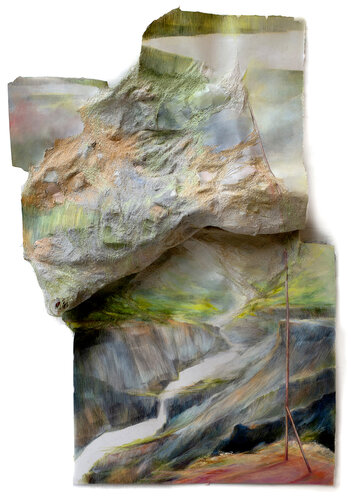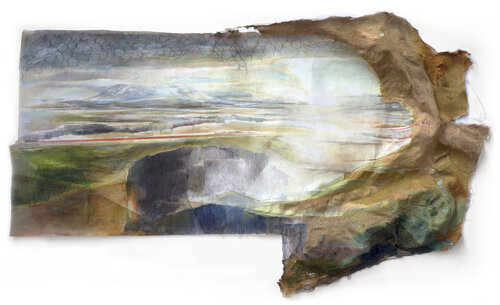Drapeau cherche territoire
Drapeau cherche territoire
Pas à pas.
Regarder un paysage de Sonia Aniceto, c’est d’abord en ressentir les aspérités et les blessures. S’aventurer dans les entrailles, longer les failles, se promener sur les crêtes et éviter la chute, le parcours ne s’annonce pas évident. Le territoire est cabossé ; composé de plis qui évoquent de la roche, un début de montagne où parfois de l’eau s’écoule. Les reliefs cousus de fils à tout moment peuvent s’échapper et prolongent l’espace au-delà des limites du cadre. Ces excroissances s’appréhendent comme des éléments de croûte terrestre, des couches qui révèlent qu’ici rien n’est lisse, ni franchement rassurant ni complètement inquiétant. L’enchevêtrement tissé peut être dense et serré ou au contraire souple et lâche, il est comme un organisme mû par sa propre volonté. Le mouvement ainsi obtenu subjugue. Puis, le regard se déplace et au sortir de la crevasse, une longue plaine s’étire.
Regarder ce paysage, c’est aussi explorer une nature désolée dans lequel la trace humaine est infime : ici un sentier usé, là une improbable structure. L’horizon est vaste. L’étendue annonce un espace sans limite. Dans cette large perspective, privé de repère, abandonné à ses sens, le marcheur progresse. L’imagination échelonne les distances. Pas de précipitation, ici le temps est suspendu. Si le décor est sauvage, il n’en est pas pour autant hostile, il s’apprécie à son rythme, avec déférence.
Regarder ce paysage, c’est percevoir une issue. De la noirceur des profondeurs, un chemin, lentement se profile. Au loin, de la clarté offre une échappée. Les couleurs, bientôt plus éclatantes, illumineront les plaines. Ces tonalités chaudes rassurent l’œil et relancent la visite. L’itinéraire n’est pas défini. Le randonneur communie avec la nature et explore le territoire à son propre rythme, contemplatif, méditatif ou rapide. Là est le secret. Une sérénité qui s’acquiert. Un calme qui apaise.
Entrer dans une œuvre de Sonia Aniceto, c’est la garantie d’un voyage émouvant.
Tamara Delvaulx
Historienne de l’art
Juillet 2022
Throughout her career, Sonia Aniceto has continued to form her own singular visual language, which is constantly evolving through her personal creative process, combining materials and techniques to create her own poetic, imaginative and inventive world.
In her recent works, she has abandoned herself to the pleasures of experimentation. The constant play between painting and embroidery fuses together to create a new medium - ‘drop paper’. She works on a fibrous paper which tames the scars and tension created by the stitching, layer after layer, the yarn transforms paper into fabric. Being more organic and flexible’ this new material lends itself to three-dimensional form. The needle is no longer used as a pencil but more as a loom, creating a new ‘skin’ which rebels until it pulls itself away from the paper. Aniceto’s works on paper form a life of their own; shapes, curves and forms appear, performed by the movement of the free machine embroidery.
The artist allows work to grow and adapt in a random manner, her embroidered interventions on the drawn support magnify the image, sometimes discreetly, almost elusively. At other times, quite evasively, the machine goes into a panic, punctuating the paper with frenzied gesticulations, crazy curls that cover and invade the drawing. In both cases, the illusion of reality is reinforced by the tactile dimension. The graphite pencil and oil pigments intertwine to better accommodate the rumblings of the machine. The delicacy of the drawing, the resilience of the paper, transparency, thickness, flexibility and tensions build a universe of intimacy, combined in both strength and fragility.
Aniceto’s work explores the invisible territory of emotions inspired by an embedded fascination with the body, childhood, places, memory and uprooting. The body and nature form an allegorical language where notions of intimacy and the mass, feelings and sensations intertwine.
Pauline Dantonel. Translation from french : Helen Beck

Sonia Aniceto
Meer van deze kunstenaar
Ontdek open calls
Word uitgedaagd door heel diverse open calls of verspreid je eigen open call hier.
Vind kunstenaars
Zoek naar kunstenaars in je buurt of naar werk in een specifieke techniek.
Ontwerp: Studio Mast | Website: eps en kaas





